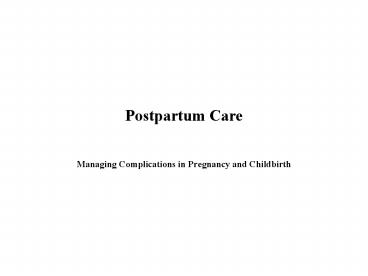Postpartum Care - PowerPoint PPT Presentation
1 / 20
Title:
Postpartum Care
Description:
Hot to touch in spite of undressing. Difficulty breathing. Lethargy. Convulsions. 14 ... Separate counseling of woman on breastfeeding and on contraception ... – PowerPoint PPT presentation
Number of Views:5262
Avg rating:3.0/5.0
Title: Postpartum Care
1
Postpartum Care
- Managing Complications in Pregnancy and Childbirth
2
Session Objectives
- To define essential elements of postpartum care
- To discuss best practices and technologies for
postpartum care
3
Objectives of Postpartum Care
- Prevent or detect and manage complications
arising during postpartum period, whether
medical, surgical or obstetric - Support mother and her family in transition to a
new family constellation - Promote and maintain physical, mental and social
well-being of both mother and newborn by
providing education on danger signals, nutrition,
rest, sleep and personal hygiene, and by
providing micronutrients, if necessary
4
Objectives of Postpartum Care (continued)
- Counsel on newborn care
- Support breastfeeding
- Counsel and provide services for contraception
and resumption of sexual activity - Immunize mother against tetanus
- Work with mother, her family and her community to
prepare a plan in case of complication
5
What is Good Postpartum Care?
- Visits at 6 hours, 6 days and 6 weeks postpartum
- Care provided by skilled provider who attended
childbirth (midwife, general practitioner or
obstetrician/gynecologist) - Integration of postpartum and newborn care
6
Components of Postpartum Care Visit
- Early detection and management of complications
- Complication readiness
- Promoting health and preventing disease
- Woman-centered education and counseling
7
Early Detection and Management of Complications
- Malnutrition General health, night blindness,
goiter - Depression/psychosis Mood
- Infection Temperature
- Pre-eclampsia Blood pressure, proteinuria
- Anemia Hemoglobin, conjunctiva/tongue/palms
- Breast problems Breast examination, assessment
of breastfeeding, newborns weight
8
Early Detection and Management of Complications
(continued)
- Subinvolution Fundal height
- Incontinence/fistula Bowel and bladder function
- Thrombophlebitis Homans sign, inspection of
legs - Genital infection Perineum, lochia/bleeding/disch
arge, rapid plasma reagin (RPR)
9
Complication Readiness
- Establish savings plan/scheme
- Make plan for decision-making
- Arrange system of transport
- Establish plan for blood donation
10
Promoting Health and Preventing Disease
- Iron/Folate 1 tablet to be taken by mouth once a
day for at least 40 days postpartum - Six monthly presumptive treatments with
broad-spectrum anti-helminthics in areas of
significant prevalence - Sleeping under a bednet
- Vitamin A One dose of 200,000 IU within 30 days
after childbirth in vitamin A deficient regions
11
Promoting Health and Preventing Disease
(continued)
- Iodine supplementation 400600 mg by mouth or IM
as soon as possible after childbirth if never
given, or if given before the third trimester
(only in areas where deficiencies exist) - Tetanus toxoid
- RPR, HIV (voluntary testing)
12
Woman-Centered Education and Counseling Danger
Signals for Woman
- Heavy or sudden increase in vaginal bleeding
- Fever
- Vaginal discharge with unpleasant odor
- Painful or hot breast(s)
- Abdominal pain
- Excessive tiredness
- Edema in hands and face
- Severe headache
13
Woman-Centered Education and Counseling Danger
Signals for Newborn
- Cord red or draining pus
- Suckling poorly
- Eyes swollen, sticky or draining pus
- Cold to touch in spite of rewarming
- Hot to touch in spite of undressing
- Difficulty breathing
- Lethargy
- Convulsions
14
Woman-Centered Education and Counseling Nutrition
- Intake should be increased by 10 (not physically
active) to 20 (moderately or very active) to
cover energy cost of lactation - Eating more of staple food (cereal or tuber)
- Greater consumption of non-saturated fats
- Avoid all dietary restrictions
- Encourage foods rich in iron (e.g., liver, dark
green leafy vegetables, etc.)
15
Woman-Centered Education and Counseling Factors
that Affect Womens Sexual Desire After Childbirth
- Fatigue and disturbed sleep patterns
- Genital lacerations/episiotomy
- Hypo-estrogenization of the vagina
- Libido
- Power issues in marriage
- Resumption of sexual activity
16
Woman-Centered Education and Counseling Family
Planning
- Inform about all contraceptive choices in
postpartum period (ideally done antenatal as
well) - Facilitate free informed choice for all women
- Reinforce that non-hormonal methods (lactational
amenorrhea, barrier methods, IUD and
sterilization) are best options for lactating
mothers - Initiate progestogen-only methods after 6 weeks
postpartum to breastfeeding women, if woman
chooses a hormonal method - Advise against use of combined oral
contraceptives in breastfeeding women in the
first 6 months after childbirth or until weaning,
whichever comes first
17
Woman-Centered Education and Counseling
Breastfeeding
- Importance, benefits and management of
breastfeeding - Positioning and attaching newborn to breast
- Need to avoid supplementary feeds
- Encourage breastfeeding on demand
18
Forms of Postpartum Care Likely to Be Ineffective
or Even Harmful
- Breastfeeding
- Limiting suckling time to 10 min. on each breast
or any other arbitrary period - Restricting frequency of breastfeeds to once in 3
hours or to any other arbitrary period - Giving artificial teats and pacifiers to
breastfed infants - Providing bottle supplements with water, glucose
or formula while breastfeeding is becoming
established - Prescribing hormonal contraceptives during first
6 weeks postpartum
19
Forms of Postpartum Care Likely to Be Ineffective
or Even Harmful (continued)
- Hormonal treatment of postpartum depression
- Separate counseling of woman on breastfeeding and
on contraception - Lactation inhibition by estrogens or bromocriptine
20
Summary
- Good postpartum care includes
- Care by skilled provider
- Focus on mother and newborn
- Multiple visits
- Detection and management of complications in a
timely fashion - Interventions and education to promote continued
good health of the mother and newborn































